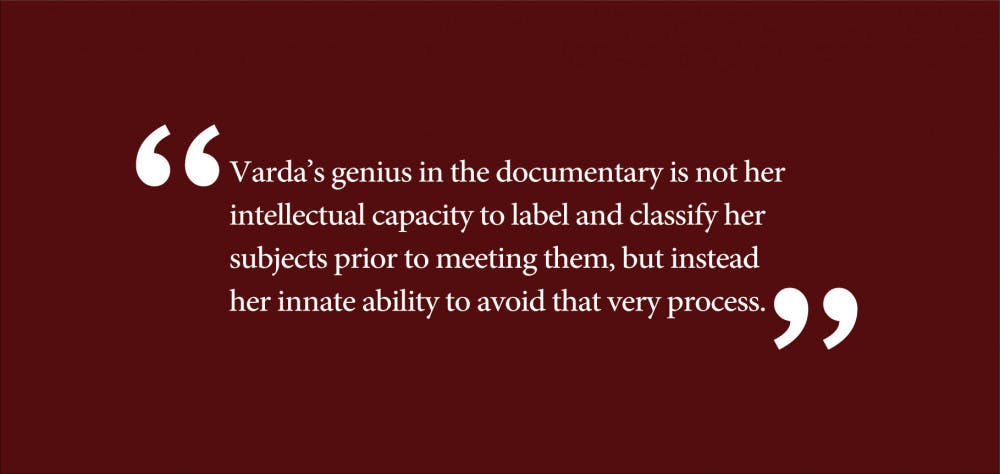There’s a scene in “Faces Places,” Agnès Varda and JR’s 2017 documentary of their trip around rural France, where they meet a woman in an abandoned public housing project. Local authorities want her to move from her lifelong home. Her neighbors already have. Varda, a trailblazer of the French New Wave who died last week at 90, and JR, a large-scale photographer, take the woman’s portrait, enlarge it and paste it on the front of her house. When the woman — we never get her name — sees the new facade of her home, she gasps. “What can I say? Nothing.” Then she begins to cry.
It is an early moment of the film, and quickly captures the essence of Varda and JR’s documentary. Varda trains her camera on people unaccustomed to ever being seen: industrial workers, goat farmers, postmen. JR expertly pastes their portrait on some local structure. And we see the reaction from those whose lives are so rarely celebrated, the wave of emotion that comes with finally feeling recognized. After Varda’s death this past Friday, I found myself rewatching scenes from Faces Places, and from “The Gleaners and I,” Varda’s 2001 documentary that follows the lives of “gleaners” in France, who scavenge harvested fields, looking for a spare potato or bunch of grapes. In both films, Varda uses her camera to illuminate the lives of the unseen. She makes fast friendships and is able to deftly emphasize the universality of her subjects.
In the Gleaners and I, her subjects are not shown to be vagabonds or hoarders; they are instead principled, stubborn and thrifty. There is a man who insists that gleaning must take place only between sunrise and sunset. We meet an urban gleaner outside a farmers market. After he finds a leftover bushel of fresh tomatoes, Varda follows him to his homeless shelter, where he teaches literature classes. Indeed, Varda is able to comprehensively depict the lives of gleaners without making them pitiable subjects. There is an amorphous respect between the two parties; filming with her digital camera, Varda walks through fields with the gleaners and peeks over their shoulders as they go about their lives.
Varda strikes a similarly intimate note in Faces Places. A delightfully unassuming documentary, it is filled with banter between the director and the photographer 55 years her junior. It is aesthetically beautiful, replete with wide shots of the French countryside and compositions of empty landscapes. But the film’s most daring aspect is how Varda chooses to parallel the films’ subjects with her own life. Just as she depicts these small towns, literally eroding before her eyes, she too examines her own mortality, albeit in a disarmingly casual manner. We see her exiting an eye exam, where she explains how her vision has grown blurry (not that it dampens her spirits). She struggles to get up a few dozen stairs, before stopping to joke that it was her exercise for the day.
And still, Varda maintains a curiosity about the lives of the supposedly unremarkable that can only be genuine. In her interviews, she elicits proud responses from her subjects, eager to finally tell their story, any story. Treating them with respect, Varda is rewarded with unabashedly honest answers. It is refreshing to see people explaining their ordinary lives with pride, a reminder that dignity begets both honesty and happiness. More impressively, Varda keeps the tone of the film light despite her honest conversations; her humor does not preclude profundity. When Varda films a goat farmer, she does so without judgement — conveying, above all, an overwhelming desire to learn and amplify the woman’s narrative. Varda is able to isolate people and moments; her interviews drown out anxieties, her questions asked without subterfuge.
Faces Places, then, while an apolitical film, nonetheless contains a message for French and indeed broader politics. As Varda and JR traverse France’s forgotten regions, they do not decide their film’s subjects in accord with any specific criteria. When they meet the aforementioned woman at the outset of the movie, they simply listen to her stories. She talks about her father, a coal miner, and his tradition of bringing entire loaves of bread into the mines. Before JR takes her portrait and pastes it onto her house, the question of whether this woman voted for Le Pen or Macron is not asked, and further, is entirely irrelevant. In our current discursive climate, in which everyone possesses an array of labels for others — both creating and ossifying tribal divisions — Faces Places shows the resolute joy that comes with the complete absence of preconceptions. Varda’s genius in the documentary is not her intellectual capacity to label and classify her subjects prior to meeting them but instead her innate ability to avoid that very process.
Of course, “Les glaneurs et la glaneuse” and “Visages Villages” comprise but a mere fraction of Varda’s cinematic legacy. This is not meant to be an obituary — a task for which I am completely underqualified — which would rightfully focus more on Varda’s significance as the only female director associated with the French Nouvelle Vague and her earlier fictitious works, such as her 1961 masterpiece Cléo de 5 à 7. But in her two 21st-century documentaries, Varda unearths shared human emotions through her ability to see the unseen, to honor the unremarkable, to elevate the ordinary.
Derek Simshauser ’20 can be reached at derek_simshauser@brown.edu. Please send responses to this opinion to letters@browndailyherald.com and op-eds to opinions@browndailyherald.com.





